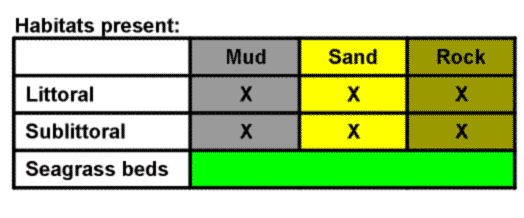Norway
| KONGSFJORDEN, SPITSBERGEN ISLAND, SVALBARD ARCHIPELAGO |
Norway |
|
|
|
|
|
| Co-ordinates: 78° 55´ N, 11° 56´ E | The inner part of Kongsfjorden, Svalbard, viewed from the settlement of Ny Ålesund. Photo Steinar Midtskogen. |
Kongsfjorden is located on the north-west coast of Svalbard. The fjord is approximately 25 m long and 5-10 km wide. At the head of the fjord is an active tidal glacier that causes marked environmental gradients in salinity, temperature and sedimentation rates, as well as bottom sediment composition. Kongsfjorden represents a border area between Atlantic and Arctic biogeographical zones. There is a wide range of habitats in the area and the bottom is very heterogenous, ranging from muds to boulders and rock substrates. Glacial deposits and drop-stones further increase habitat diversity.
Description of fauna and flora:
 Above water, Kongsfjorden appears truly Arctic, with winter ice-cover in parts and resident populations of various ice-dependent marine mammals (seals, walrus and polar bears) and Arctic birds. However, because the water column is strongly influenced by Atlantic water masses, the benthic macrofauna contains a greater proportion of Atlantic than Arctic taxa. In the pelagic zone, there is a complex mix of Atlantic and Arcticorganisms.
Above water, Kongsfjorden appears truly Arctic, with winter ice-cover in parts and resident populations of various ice-dependent marine mammals (seals, walrus and polar bears) and Arctic birds. However, because the water column is strongly influenced by Atlantic water masses, the benthic macrofauna contains a greater proportion of Atlantic than Arctic taxa. In the pelagic zone, there is a complex mix of Atlantic and Arcticorganisms.
Human impact:
The only settlement in Kongsfjorden is Ny Alesund, which has an average of 40 residents. Coal mining was carried out there until 1962. Since then, the settlement has become a research facility. Rigorous waste management is carried out.
Facilities:
Kongsfjorden is accessible all year round by plane from Longyearbyen or by boat. There are fully equipped research facilities, run by Kings Bay AS, including laboratories, accommodation and catering.
Avaiable database end website:
Norwegian data are stored by the University Courses on Svalbard, the University of Tromso, the Norwegian Polar Institute and the Norwegian Institute for Nature Research (NINA) and Akvaplan-niva. Databases also exist internationally (including Germany, Poland, UK and Russia).
Commitment and ongoing research:
A wide range of European institutes conduct biodiversity research on Kongsfjorden. An agreed science plan exists between Norwegian and Polish institutes.
